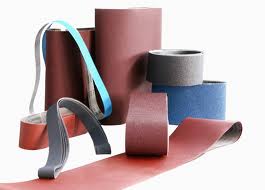
In previous articles, iAbrasive.com has introduced the current situation, application fields and grinding technology of abrasive belts. This article explains what problems can be solved by inorganic polymer binder in abrasive belt application.

In previous articles, iAbrasive.com has introduced the current situation, application fields and grinding technology of abrasive belts.
(Related articles: http://www.iabrasive.com/articles/current-situation-of-abrasive-belts-grinding-and-major-application
http://www.iabrasive.com/articles/main-characteristics-and-advantages-of-abrasive-belt-grinding-techniques)
In this article iAbrasive will explain in detail what problems can be solved by inorganic polymer binder in abrasive belt application.
The techniques of abrasive grains and abrasive belt products processing are important factors that mark the development of abrasive belt grinding technology. The capability to manufacture high-quality abrasive belt has become a criterion for a nation's abrasive belt grinding technology. Inorganic polymer binder has been applied in coated abrasives, especially in powerful and precision grinding and has offered solutions for short service life of abrasive belts. Use of inorganic polymer binder has facilitated the progress of abrasive belt grinding.
The service life of abrasive belts made in China is usually 2 hours to 4 hours, while the service life of foreign abrasive belts is 8 hours to 12 hours. In terms of abrasive grain types, the most frequently used types in China are Sic and Al2O3. So far, little has been done in the development of diamond abrasives, ceramic aluminum oxide, abrasive compound, and grouped abrasives. Inorganic polymer binder was used to improve the structure of abrasive grains. In aspects of abrasive belt structure, grouped abrasives sand belts and high elastic abrasive belts have been developed.
Due to the fact that coated abrasives processing fields are expanding continuously into steel, iron casting, stainless steel, alloy steel, High density fiberboard, plywood, glass, feather, etc., traditional abrasives, such as fused alumina and Sic, can no longer meet the demand. In recent years, with improvement of processing techniques, new types of materials sprung up. Zirconia alumina, superhard abrasives, grouped abrasives, abrasive compound, and SG abrasive, just to name a few. According to relevant report, Norton Abrasives has launched TG abrasive which is a breakthrough in the shape of abrasive grains. It is proper for creep feed grinding and processing difficult-to-machine materials, such as titanium alloy. The materials' removal rate of TG abrasive is 4 times the zirconia alumina and its service life is 10 times the fused alumina. Currently, large abrasive belt producers worldwide have adopted these abrasives types, which have become an important direction in abrasive belt abrasives.
The secret lies in inorganic polymer binder is that it is cured by nano particles polymerization. Since particle sizes decide the materials' microstructure and macroscopic performance, inorganic polymer binder has unique performances, such as improved toughness, high tenacity, high sharpness, etc.
Author: Liwei Chu
Copyright: iAbrasive.com--Abrasives & Diamond Tools Market